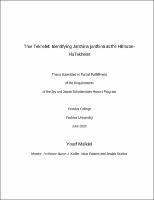Please use this identifier to cite or link to this item:
https://hdl.handle.net/20.500.12202/5686Full metadata record
| DC Field | Value | Language |
|---|---|---|
| dc.contributor.advisor | Koller, Aaron J. | - |
| dc.contributor.author | Yeshiva University, degree granting institution. | - |
| dc.contributor.author | Malkiel, Yosef | - |
| dc.date.accessioned | 2020-06-18T14:10:06Z | - |
| dc.date.available | 2020-06-18T14:10:06Z | - |
| dc.date.issued | 2020-06 | - |
| dc.identifier.citation | Malkiel, Yosef. True Tekhelet: Identifying Janthina janthina as the Hillazon-HaTekhelet. Thesis Submitted in Partial Fulfillment of the Requirements of the Jay and Jeanie Schottenstein Honors Program. NY: Yeshiva College. Yeshiva University, June 2020. Mentor: Professor Aaron J. Koller, Near Eastern and Jewish Studies. | en_US |
| dc.identifier.uri | https://hdl.handle.net/20.500.12202/5686 | - |
| dc.description | Senior honors thesis. Open Access. | en_US |
| dc.description.abstract | Abstract Tekhelet dye that was once used in the biblical era for dyeing the curtains of the Tabernacle, the clothes of the High Priest, and the ritual fringes attached to the clothes of Jewish men is derived from the mysterious hillazon according to Mishnaic and Talmudic literature. After an effort was made beginning in the late 1800’s to identify the modern day creature that represents the hillazon and revive tekhelet production, Rabbi Herzog wrote a dissertation on the identity of the hillazon, the definition of tekhelet, and the history of the ancient purple and tekhelet dye industry, resting on two potential genera from which the hillazon can be identified: Murex and Janthina. The Murex trunculus of the first genus mentioned has been identified as the hillazon by dye chemists and the Ptil Tekhelet group, the current producers of tekhelet-dyed ritual fringes, despite the Murex trunculus failing to match many of the criteria of the hillazon mentioned in Talmudic and Rabbinic literature. Due to the success of Murex trunculus in dyeing, the Janthina genus has almost been forgotten as being proposed by Rabbi Herzog, who was more convinced of Janthina being the hillazon than the Murex. This paper has shown that Janthina janthina, the most commonly found species of Janthina in the Mediterranean, fits all the criteria describing the hillazon. While the Murex trunculus has gone through years of dye fastness testing, the Janthina janthina has yet to go through such tests. Janthina janthina may be the hillazon, the producer of true tekhelet dye. | en_US |
| dc.description.sponsorship | Jay and Jeanie Schottenstein Honors Program | en_US |
| dc.language.iso | en_US | en_US |
| dc.publisher | New York, NY: Yeshiva College. Yeshiva University. | en_US |
| dc.relation.ispartofseries | The Commentator;June 2020 | - |
| dc.rights | Attribution-NonCommercial-NoDerivs 3.0 United States | * |
| dc.rights.uri | http://creativecommons.org/licenses/by-nc-nd/3.0/us/ | * |
| dc.subject | Senior honors thesis | en_US |
| dc.subject | tallit | en_US |
| dc.subject | Hillazon-Hatekhelet | en_US |
| dc.subject | Murex trunculus | en_US |
| dc.subject | tekhelet | en_US |
| dc.subject | Janthina janthina | en_US |
| dc.subject | Velella velella | en_US |
| dc.title | True Tekhelet: Identifying Janthina janthina as the Hillazon-HaTekhelet . | en_US |
| dc.type | Thesis | en_US |
| Appears in Collections: | Jay and Jeanie Schottenstein Honors Student Theses | |
Files in This Item:
| File | Description | Size | Format | |
|---|---|---|---|---|
| Yosef Malkiel Thesis OA May2020.pdf | 2.28 MB | Adobe PDF |  View/Open |
This item is licensed under a Creative Commons License

